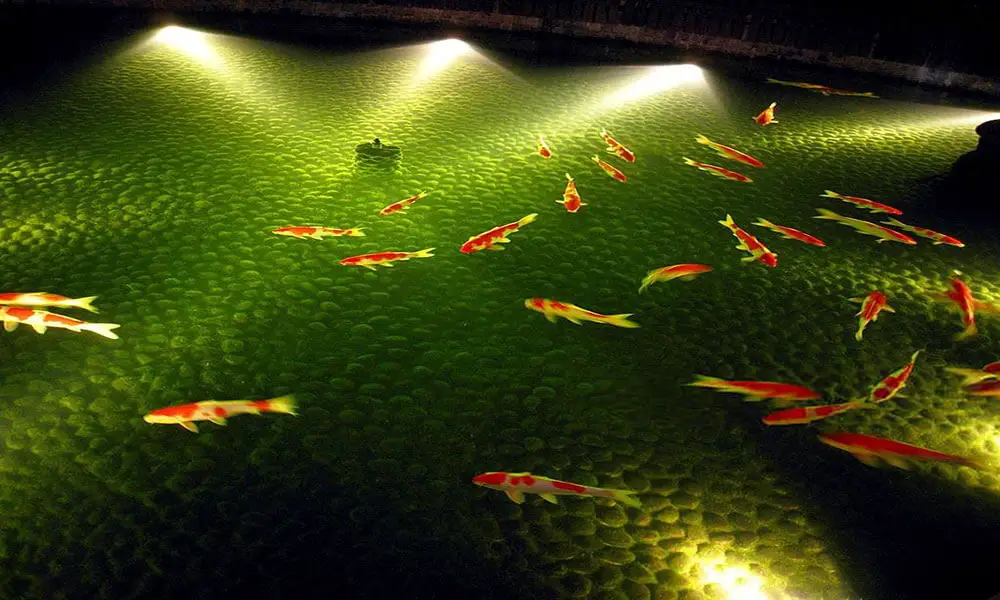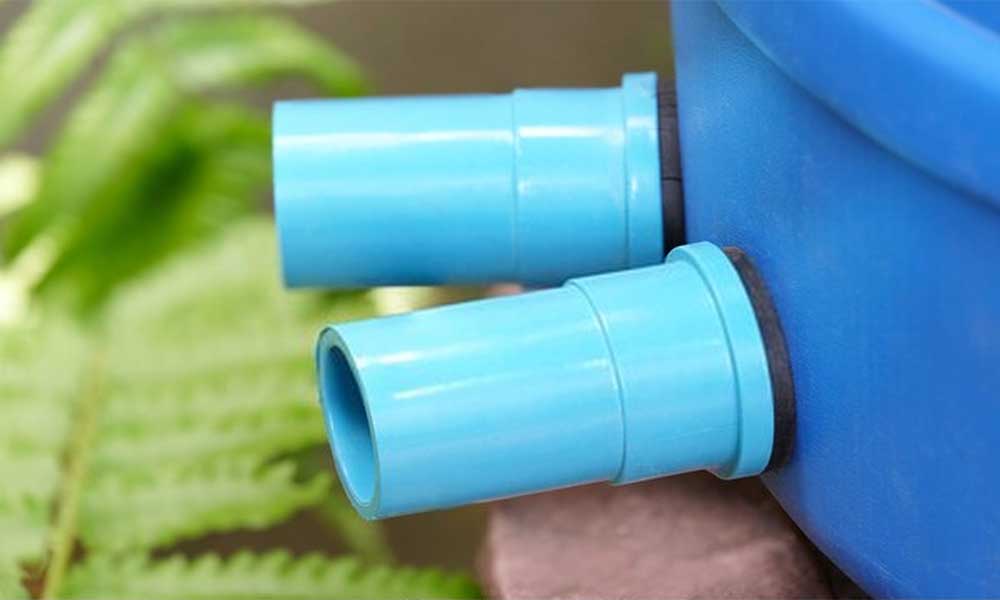Products recommended in this post contain affiliate links. If you buy something through our posts, we may receive a commission at no extra charge to you. See our full disclosures here.
If your pond has been taken over, hunting down the best pond algae remover can mean the difference between completely rebuilding your pond from the ground up and taking care of the bloom before it gets to that point.
If that sounds like you, this guide is going to help you find the best algae removers while also understanding how to control the bloom and how to prevent it from happening again. You’ll also see a handful of tips and steps to use to protect your pond from the algaecides and the algae!What’s The Best Natural Algae Remover?
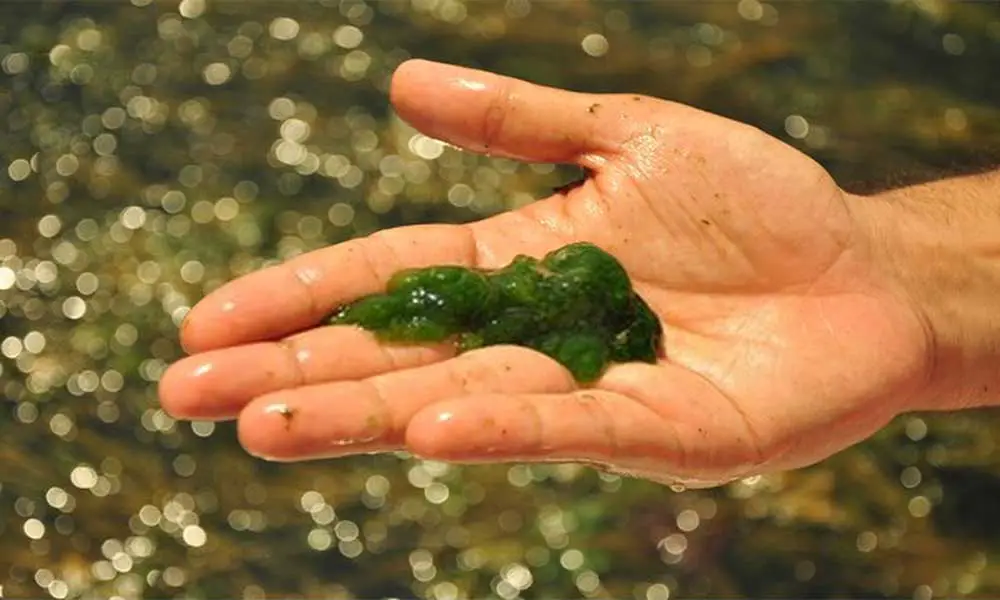
Natural algae removers work differently than chemical algae removers. Instead of directly attacking the algae and killing them, natural algae removers focus on promoting healthy bacteria that starve the algae for the nutrients they require to thrive.
In other words, a natural algae remover uses nature to defeat algae by creating an environment that isn’t conducive to them being able to bloom and grow out of control. Most natural algae control methods are safe for fish and plants.The Nualgi Ponds Natural Algae Remover is a unique blend that helps promote algae growth, which also reduces algae growth. By promoting the Diatom species of algae, the Diatom that grows will begin to starve more nuisance and harmful types of algae of their nutrients.
If you have a stocked fish pond, the Nualgi Ponds Natural Algae Control is one of the best pond algae control methods you can use. Instead of using harsh chemicals to eradicate algae, the product replaces one for another.
Your fish can feed on the Diatom algae, where other types of algae are only considered a nuisance and cannot be processed by your fish. The smaller organisms that live in your pond will be able to consume the new organic material being produced.
As your population of Diatom algae grows, the smaller plankton will begin to grow as well. The plankton is what your fish will feed on, so you’re (effectively) introducing a new ecosystem that makes it harder for harmful algae to reproduce.
Plankton prefers feeding on Diatom algae over other forms and will photosynthesize faster than algae can. This means, as time goes on, the plankton will outgrow the algae, and then they will begin feeding on themselves.
Instead of dealing with an algae problem, your plankton will remove themselves from the ecosystem once they are done decimating the algae population. The Nualgi Ponds also helps increase the oxygen levels in your water.
As plankton and algae grow and begin consuming more oxygen while releasing higher levels of carbon dioxide, the Nualgi Farms will aid in balancing the nutrients in your water so that your fish and plants are not harmed during the time plankton are feeding on algae.
The biggest downside to this product is that it is often a slower method than what you’re going to see with most chemical products. Chemicals are more effective at removing algae quickly, but have their potential downsides, as well.
Nualgi Ponds also works mainly against free-swimming types of algae. It is not considered highly-effective when you are dealing with existing blooms of string algae or blanket weeds. If you have a massive bloom of either, you may want to consider other options.
To help ensure you get optimum results, you will want to consider adding Nualgi Ponds with a beneficial bacteria treatment. This will guarantee that the products work together side-by-side to improve your water’s clarity and create an environment where the plankton can thrive.
For stocked fish ponds and ponds with large numbers of plants, the Nualgi Ponds Algae Control is one of the best solutions you have available right now. It is safe to use, and your fish will have a new snack to feast on once the plankton starts growing and decimating the algae population.What’s The Best Chemical Algae Removers?
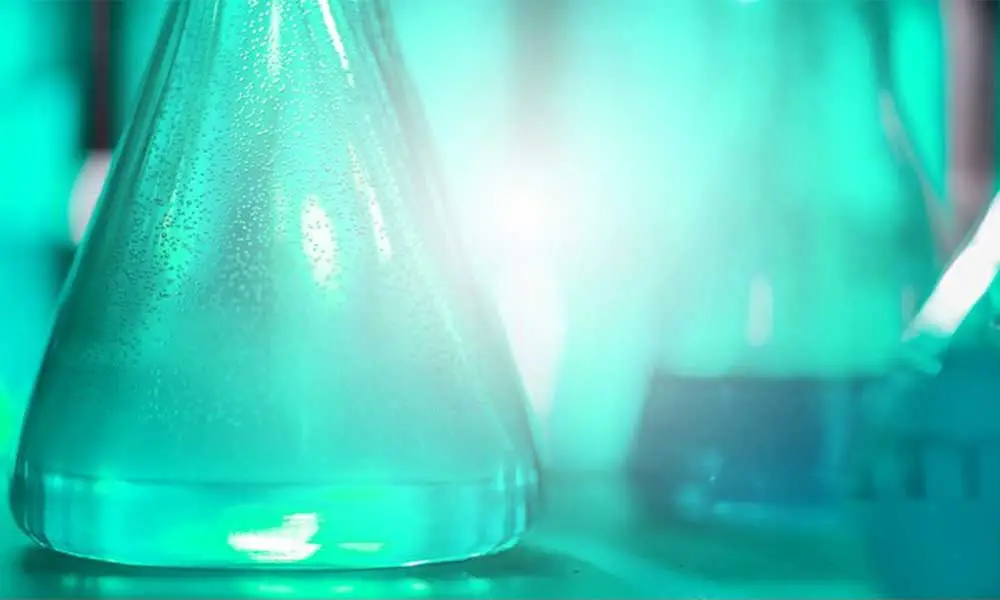
When time is of the essence, or you don’t have time to wait for natural algaecides to begin working their magic, chemical algae removers are your next best option. Chemical algae removers go straight to the heart of the problem.
Instead of creating a new ecosystem where algae are unable to thrive, chemical algaecides kill algae where they stand. While chemicals do work faster than natural algaecides, you will need to follow a few precautions before using them.
Below are two of the best chemical algaecides we’ve found.1. TetraPond Algae Control Treatment
One of the most commonly known brands in the pond keeping industry is TetraPond. The TetraPond Algae Control Treatment is incredibly powerful and helps to oxidize both string and free-swimming algae.
TetraPond Algae Control is designed to be safe for both plants and fish, but you will still need to ensure you are following the directions. Because it uses chemicals to kill the algae, you will need to understand the stress that your fish and plants will be under before using it.
If you aren’t already adding aeration to your pond, you will need to install an aerator before using TetraPond or any other chemical treatments. If you do not currently have any fish inside of the pond, the TetraPond can be used without worry.
The active ingredient inside of TetraPond’s Algae Control is designed to kill algae quickly while removing the green water that allowed the algae to thrive. Dead algae will begin to sink to the bottom of the pond to be picked up in your filtration system or vacuum.
TetraPond is also highly-effective against nearly every type of algae you will encounter, from Diatom to string algae, free-swimming, and various kinds of harmful or toxic algae.
For most people and most ponds, a single dosage of TetraPond is all you’re going to need to remove the bloom altogether. If you’re dealing with a complete outbreak, though, you may need to apply two to three treatments before allowing your pond to recover.
2. GreenClean Granular Algaecide
If you have a larger pond or a complete takeover of algae and need something a little more industrial than what TetraPond has to offer, the GreenClean Granular Algaecide is your next best bet.
The GreenClean is formulated to help efficiently eliminate string algae, and other surface algae bloom. It has been approved by the EPA and USDA to be organic compliant, so it is safe for your fish and plants whenever you are following the instructions properly.
GreenClean is designed to kill algae on contact, so you’re going to need to go in with proper aeration and filtration system, while also vacuum or raking the dead algae out of the pond as quickly as possible.How To Remove Algae In A Stocked Pond
Having an algae problem in a pond that you keep fish and plants in can be one of the most frustrating aspects you will encounter. Taking care of your fish and plants while also getting rid of the algae problem requires a particular approach.
Step 1: Plan the sections you’ll treat.
This step is especially essential if you are treating a large pond.
Before you start, you’re going to want to map out sections in your pond so you can treat them one by one. Splitting the pond into sections will help you avoid overdoing it or dramatically reducing the oxygen levels in the water.
Once you treat a single section, you can wait up to a week before processing the next. This will help you determine whether or not you need to continue adding more algaecide or if the dosage amount you have already used is enough to use in the next section.
Giving your pond a break between treatments will help you rebalance the oxygen levels inside of the water. It will also help you minimize the amount of stress you are putting your fish and plants through.
Step 2: Add an aeration pump.
After you apply a treatment, you will want to ensure that you are maintaining safe levels of oxygen inside the water. Algaecide (and algae, in general) will reduce the oxygen in your pond.
Low oxygen levels are going to put your fish under undue stress, but adding an aeration pump as you’re treating the water can help reduce the stress.
You aeration pump can be anything from an oxygenation system that’s submerged in the bottom of the pond to a powerful waterfall or fountain. A diffuser system is going to be your best bet if you can afford to add one to your system.
Step 3: Keep the filtration system clean.
When you are treating your water, the dead algae and the algaecide you’re using to kill them are going to begin building it. It will need to go somewhere, so it doesn’t stay in your pond.
That means it’s either going to end up as sludge on the bottom of your pond or inside of your filtration system. Depending on the number of dead algae you’re dealing with, your entire filtration system could become clogged and malfunction.
Smaller filtration systems will quickly become ineffective as they get clogged. If you are not properly maintaining them as you are treating the pond, you could end up replacing the filtration system by the time you’re done.
To avoid this added expensive, open your filter and remove the filter media. Spend a few minutes washing it down before putting it back in the pump.
The bacteria inside of your filtration system will begin to break down the algae but, once it becomes clogged, it will stop being as productive. If your system becomes clogged, your pump could overheat and suffer a quick death.
Step 4: Vacuum out sludge and debris.
The dead algae that aren’t being pulled into your filtration system are going to settle in the deeper areas of your pond. The algae will start to decompose and create harmful ammonia, nitrites, and nitrates.
Ammonia, nitrites, and nitrates will help new algae begin to bloom, which essentially offsets all of the hard work you’ve done up to this point.
While treating your pond, we recommend using a pond vacuum or rake to start collecting the algae as it is dying and settling on the bottom. If you’re dealing with a large amount of sludge or scum, you can also use natural treatments that help break it down over time.
Sludge removal treatments work great when you’re using a pond vacuum to remove the buildup as it starts to accrue. Together, a vacuum and sludge removal treatment will make your life significantly easier when you’re trying to get rid of a huge algae problem.
Step 5: Put activated carbon in your filter.
Once you have completed the treatment of your pond, you’re going to need to take your filtration system one step further and add activated carbon charcoal.
Activated carbon charcoal works to remove the harsh chemicals that you added into the water to get rid of the algae in the first place. The extra chemicals will all be neutralized by the charcoal filtration.
Once you are sure that the algae problem has been significantly reduced or completely removed, the activated carbon charcoal in a mesh bag inside of your filtration system will keep the residual chemicals at levels low enough that they will not harm your fish or plants.
By removing these residual chemicals, your filtration system can work harder to keep the algae bloom from returning.
Step 6: Follow the directions!
Now, this is a small tip, but one that you need to take extra precaution to ensure you follow.
Every manufacturer is going to have specific instructions on the back of the package that their algaecide comes in. You need to follow those instructions and avoid making up your treatment routine.
The instructions are listed for a particular reason: not following them will harm your fish, your plants, your pets, and even you if you improperly ingest them.
Spend time reading through the manufacturer’s recommended steps, taking note of the size of your pond, how many plants, and how many fish you have. The label will tell you the recommended dosage and treatment schedule you should be following.
Then, ensure that you are using the right type of algaecide for the algae that you’re dealing with.Different Types Of Pond Algae
There are a handful of different algae types that you’re going to encounter when you notice your water changing colors. Each type of algae will need to be dealt with in a specific way. The significant types you’re going to encounter are listed below.
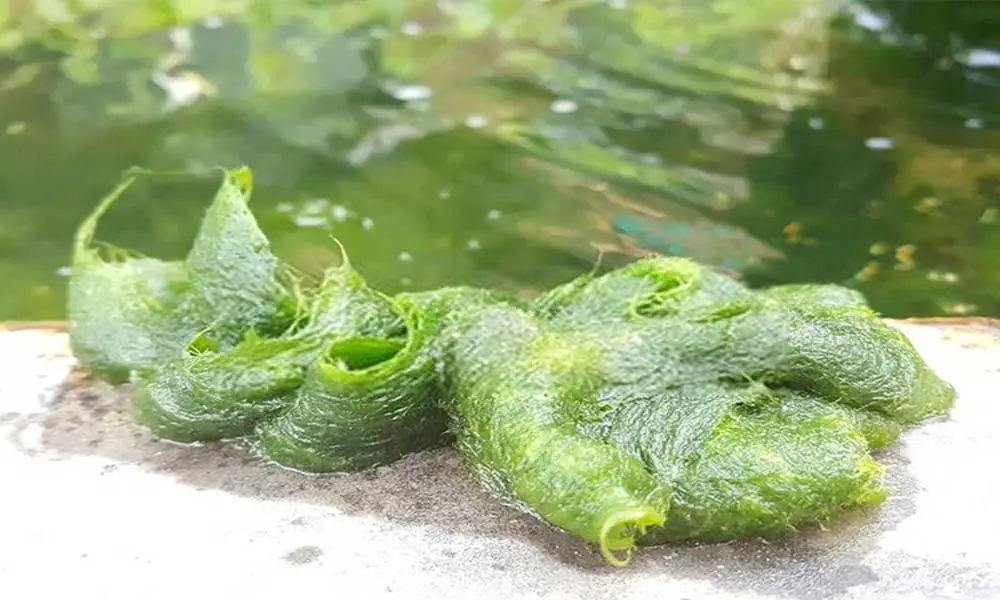
filamentous algae
This is the most common type of algae, most commonly referred to as “pond scum.” It typically builds up around the surface of your water and forms thick mats. You’ll notice it around the edges of rocks and logs. The algae form hair-like mats that are cells connected in one large mass.planktonic or string algae
String algae, or planktonic algae, is another type of surface bloom. These resemble tiny plants that range in color from green to brown and create a foul smell. String algae are also known for removing oxygen from the water, which can harm your fish and plants. They are also known for being toxic to humans and pets.toxic algae
Toxic algae is a blue-green species of algae that produce a poisonous mixture that is known for causing death in humans and animals. This type of algae should only be dealt with my professionals.colonial diatoms
Colonial Diatoms, as the name implies, are known for growing in small colonies. This type of algae is most typically found around sand and rocks. It has a grey or brown appearance and will usually need to be controlled using chemical methods.resistant algae
Resistant algae have a small protective film that makes it resistant to most methods of treating it and algaecides that are produced today. The horsehair algae are usually dark green and grow in clumps that appear similar to steel wool. You’re generally going to find resistant algae growing at the bottom of your pond.
Is Using Algaecides The Right Choice For You?
Pond scum (as most refer to it) or pond algae is something that you’re going to have to deal with at some point in time. Developing algae bloom in pond environments and ecosystems is an inevitable side effect of maintaining an outdoor water garden.
While there are quite a few different pond algae solutions, each focused on a different type of pond algae, deciding on whether or not to use those algaecides in your pond is entirely up to you.
For most people, dealing with an algae takeover may never be a problem on their agenda. For some, though, a complete takeover of their outdoor water garden is something that they are going to encounter and need solutions to defeat or control the algae bloom.
Getting rid of algae with non-chemical means is usually the best remedy. Non-chemical remedies, though, may not always be effective and often act slower than most chemical remedies available today will act.Pond Clarifiers
Pond clarifiers are an excellent method for removing green water algae and other types of free-swimming blooms. A quality clarifier can also help control future outbreaks.
Clarifiers are only effective at controlling specific types of algae, though. If your pond is suffering from green water, a UV clarifier will typically be enough to control the bloom. If you suffer from other types of algae, though, such as string algae, clarifiers will not be enough.Chemical Algaecides
Chemical algaecides and herbicides are incredibly effective at controlling algae. With their effectiveness, though, comes potential hazards.
If you are keeping fish or plants in your pond, a high-strength herbicide is going to cause damage to them. In the case of planted or stocked ponds, we recommend using non-chemical methods unless necessary.
Treating the pond with a clarifier is always going to be less hazardous to your plants and fish, even if it does take multiple treatments. Mixing a combination of both clarifiers with manual cleaning methods can effectively remove the bloom in your planted and stocked ponds.
Are Algaecides Safe For My Pond?
As long as you are using them correctly and taking proper precautions to ensure you aren’t introducing toxins into your ecosystem, most algaecides are safe for fish and plants.
The chemicals that you’ll find inside of algaecides do not directly impact your plants and fish whenever you are applying proper dosages. The problem for your fish and plants come from the algae beginning to die off.
As algae die, they will begin robbing the water of the much-needed oxygen your fish and plants require to survive. The lower oxygen levels are depleted even further as the decomposing algae start building up.
To keep from having this problem, you’re going to want to add aeration to your pond as you are introducing algaecides. You will also want to ensure that you are removing dead algae before it gets a chance to begin decomposing and robbing the water of oxygen.
If you aren’t able to aerate your pond, you can either remove the fish and plants, introducing them to a new location, or avoid using algaecides altogether.
If you have large numbers of fish in the pond, you could already run the risk of low oxygen levels. Even the heaviest duty aeration systems may not be able to handle the extra load of algae dying and robbing oxygen.
For ponds with more significant numbers of fish, you will need to stick to a more in-depth cleaning procedure while also delivering as much oxygen as possible. Regularly testing your water’s oxygen levels will help you get in front of any potential problems.Video Introduction
What’s The Best Pond Algae Control?
The answer to this question is, ultimately, determined by the type of bloom you’re trying to control and whether or not you have fish and plants in the pond.
If you are looking for the best organic pond algae control, we have found that the Nualgi Ponds Algae Control is the best of the best.
However, if you’re looking to get the job done as soon as possible and are comfortable adding chemical algaecides to your pond, the TetraPond Algae Control is excellent for smaller ponds while the GreenClean Granulated Algae Control is a better option for larger ponds.Top Editor's Choice on Pond Algae Control
[amazon bestseller="Pond Algae Control" filterby="price" filter="30" filter_compare="more" filter="available" orderby="percentage_saved" order="desc" template="list" items="10" tracking_id="tnk0c-aawp-cro-b-20"]Subscribe to our Newsletter!
Join our mailing list to receive the latest tips and news of our blog.


 Check Offer Prices [Amazon]
Check Offer Prices [Amazon]

